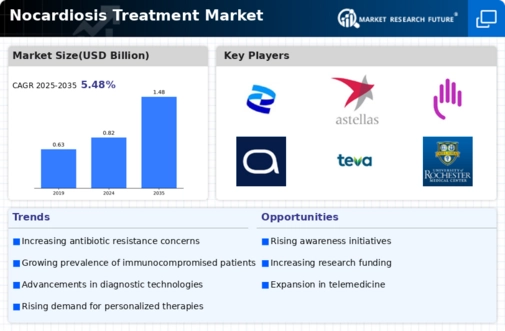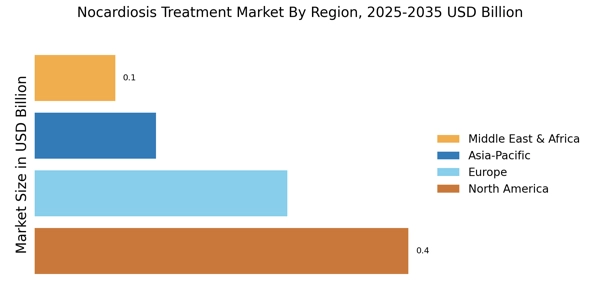Emergence of Combination Therapies
The emergence of combination therapies represents a noteworthy trend within the Nocardiosis Treatment Market. As research continues to evolve, the effectiveness of combining different therapeutic agents is being recognized as a viable strategy to enhance treatment outcomes for nocardiosis. This approach may not only improve efficacy but also reduce the risk of resistance development. The growing body of evidence supporting combination therapies is likely to encourage healthcare providers to adopt these strategies in clinical practice. Consequently, this trend could lead to an expansion of the treatment landscape, fostering innovation and competition within the Nocardiosis Treatment Market.
Increasing Incidence of Nocardiosis
The rising incidence of nocardiosis is a pivotal driver for the Nocardiosis Treatment Market. Reports indicate that the prevalence of this infection has been on the rise, particularly among immunocompromised individuals. This trend is likely to escalate the demand for effective treatment options. As healthcare providers become more aware of the disease, the need for targeted therapies and innovative treatment modalities is expected to grow. The increasing number of reported cases suggests a pressing need for research and development in this area, which could lead to the introduction of new drugs and therapies. Consequently, pharmaceutical companies are likely to invest more resources into the Nocardiosis Treatment Market, aiming to address this emerging health concern.
Advancements in Diagnostic Techniques
Advancements in diagnostic techniques are significantly influencing the Nocardiosis Treatment Market. Enhanced diagnostic tools, such as molecular methods and advanced imaging techniques, facilitate earlier and more accurate detection of nocardiosis. This early detection is crucial, as it allows for timely intervention and treatment, potentially improving patient outcomes. The integration of these advanced diagnostics into clinical practice is likely to drive the demand for effective treatment options. As healthcare systems adopt these technologies, the Nocardiosis Treatment Market may witness a surge in the development of targeted therapies that align with the specific needs of diagnosed patients. This trend underscores the importance of innovation in both diagnostics and therapeutics.
Rising Investment in Antimicrobial Research
Rising investment in antimicrobial research is poised to impact the Nocardiosis Treatment Market positively. With the growing concern over antibiotic resistance, there is an increasing focus on developing new antimicrobial agents that can effectively combat nocardiosis. Pharmaceutical companies and research institutions are allocating substantial resources to explore novel compounds and treatment strategies. This investment is likely to yield new therapies that are more effective against nocardiosis, thereby expanding the treatment options available in the market. As a result, the Nocardiosis Treatment Market may experience significant growth driven by the introduction of innovative and effective antimicrobial treatments.
Growing Awareness Among Healthcare Professionals
Growing awareness among healthcare professionals regarding nocardiosis is a significant driver for the Nocardiosis Treatment Market. As medical education evolves, more practitioners are being trained to recognize the symptoms and risk factors associated with this infection. This heightened awareness is likely to lead to increased diagnosis rates, which in turn could drive demand for effective treatment options. Furthermore, as healthcare professionals become more informed about the latest treatment protocols and emerging therapies, they may be more inclined to prescribe innovative solutions. This trend suggests a potential increase in market growth as the medical community actively seeks to improve patient care in relation to nocardiosis.


















Leave a Comment